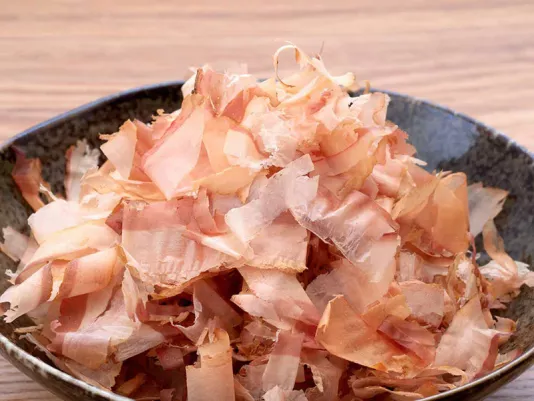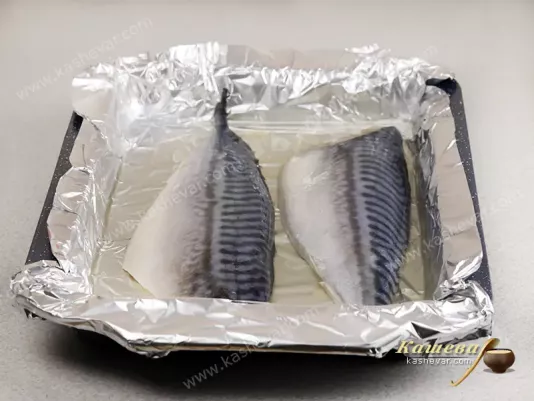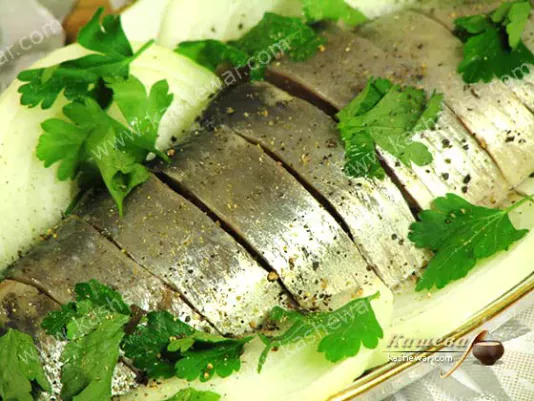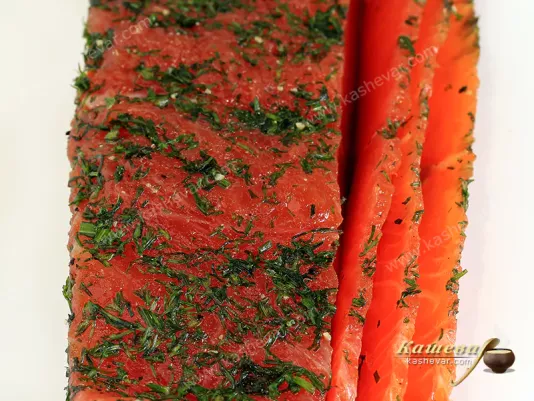Processed Fish
Processed fish is a category of ingredients I value for their rich flavor, versatility, and ability to diversify the diet. Salted and marinated fish varieties help create classic appetizers, salads, and sandwiches, while smoked fish becomes the centerpiece of a festive table. What is important to me is that such ingredients preserve the beneficial properties of fish while giving dishes a new dimension. From sprats and herring to salmon and katsuobushi – every type of processed fish has its own character and culinary purpose. I always turn to this category when I want to prepare a dish with a vivid taste that leaves a lasting impression.
Different Types of Processed Fish
Salted Fish
Salted fish has always held an honorable place in my cooking, as it provides dishes with depth of flavor and a unique character. A classic example is herring, which I often use in salads and appetizers. For me, “herring under a fur coat” or herring with onions and oil are not just dishes, but part of a culinary tradition that always brings family together. Salted sprats also deserve attention: their tender flesh with a pronounced flavor pairs well with bread, boiled potatoes, or in simple appetizers. I also want to highlight salted salmon and red fish. I value their delicate taste for its versatility: such fish is equally suitable for festive sandwiches, sushi rolls, or light salads. It adds refinement to dishes and makes the menu more diverse. I always advise paying attention to the degree of salting: lightly salted fish is ideal for daily consumption, while stronger versions are better used in dishes with bold accents. Salted fish is not only delicious but also healthy when eaten in moderation. It retains valuable proteins, omega-3 fatty acids, and vitamins, which makes it an important part of the diet. In my experience, it becomes indispensable when you need to quickly prepare something hearty and nutritious. I am convinced that salted fish is a product that deserves a place in every kitchen, as it combines tradition, benefits, and unique taste.
Marinated Fish
For me, marinated fish is always an exciting combination of tenderness and pronounced flavor that makes any dish special. I often use marinated mackerel, as it is perfect for light appetizers and festive meals. Thanks to the marinade, its flesh becomes soft, aromatic, and juicy, while the flavor takes on new dimensions. In my practice, marinated fish pairs well with potatoes, fresh vegetables, herbs, and even fruits such as lemon or orange. Such combinations add originality and freshness to dishes. Marinades allow you to change the character of the fish. If I want to emphasize tenderness, I use a light marinade based on vinegar, lemon juice, and olive oil. When I want something spicier, I add spices, garlic, and a little chili pepper. This way, the same fish can have completely different flavor profiles. I have found that marinating opens new culinary possibilities, letting me adapt fish to different moods and occasions. Besides mackerel, I have tried marinating other fish, and the results were always worth it. Marinated fish is a versatile product that can be served as an appetizer, used in salads, or made into the base for sandwiches. For me, it is a great example of how a simple process can transform ordinary fish into a delicacy with character.
Smoked Fish
Smoked fish always gives my dishes a refined aroma and a special aftertaste that is hard to reproduce by other cooking methods. I often use smoked mackerel – its rich flavor and tender texture make it ideal for salads, appetizers, and even pasta. Smoked salmon for me is a delicacy I serve with toast, cream cheese, and herbs. In such combinations, it always becomes the highlight of the table, whether for a festive meal or a light breakfast. The smoking process not only adds flavor but also extends the shelf life of the fish, which makes it practical for daily use. I love pairing smoked fish with vegetables, eggs, or potatoes, as its aroma contrasts perfectly with simple ingredients, creating a harmonious balance. At the same time, in more complex dishes, smoked fish can serve as the main accent – for example, in pasta with cream sauce or in a spicy cream soup. For me, it is important to choose high-quality smoked fish that has preserved its natural taste and tenderness of flesh, not just smoky notes. I have noticed that even a small amount of smoked fish can completely transform a dish, adding depth and expressiveness. It is one of those ingredients I always keep in the fridge to prepare simple but memorable meals.
Practical Tips for Using Processed Fish
From my experience, processed fish requires careful handling to maximize its flavor and benefits. I always try to balance saltiness with neutral ingredients. For example, herring or sprats go perfectly with boiled potatoes, herbs, and fresh vegetables – this way, the dish becomes harmonious and light. If the fish is too salty, I sometimes soak it in water or milk before use to soften the taste. This is a simple method I often use at home. I use smoked fish in small amounts, as its flavor is very intense and can dominate a dish. I like to pair it with creamy sauces or neutral side dishes such as rice or pasta. This helps achieve balance, and the dish does not overwhelm the palate. I serve marinated fish with crunchy vegetables and lemon – this makes the flavor brighter and fresher. I also want to note storage: processed fish should be kept in the fridge and consumed within the recommended time, as it quickly loses quality. I always pay attention to origin and freshness, since they affect not only taste but also safety. For me, processed fish is not just an ingredient but a true palette of possibilities: from classic appetizers to modern experiments. It helps create dishes that combine tradition and new culinary ideas.
Processed Fish as a Source of Culinary Inspiration
For me, processed fish is an ingredient that always inspires creativity and helps expand the boundaries of the usual menu. I value it because it allows me to combine simple products with refined flavor accents. Even an ordinary sandwich with smoked mackerel or salted salmon turns into a sophisticated appetizer, while a salad with marinated fish becomes a festive dish with no extra effort. In my practice, processed fish has often helped me create new recipes that were loved by both my family and guests. I am convinced that this category of products successfully combines tradition and modernity. On the one hand, herring or sprats are classics familiar to everyone. On the other, katsuobushi or salted tuna open the door to new culinary cultures and techniques. It is precisely this variety that makes processed fish so interesting to me. It allows me to prepare dishes that are always different yet remain understandable and delicious. In my experience, working with processed fish teaches attentiveness and respect for the product. I always treat it as a special ingredient that deserves the right choice of side dishes and serving methods. Thanks to this, I constantly discover new variations of dishes and truly enjoy the process. For me, processed fish is not just food but also a constant source of culinary inspiration.






